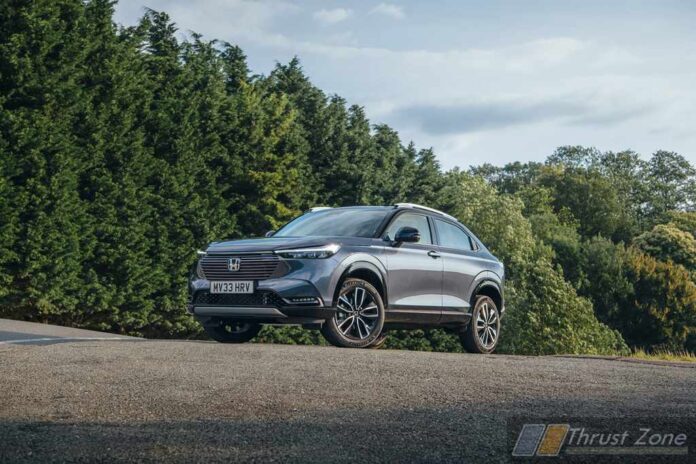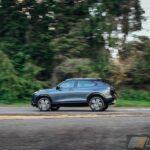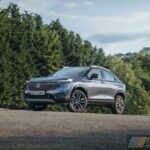Honda HRV India will be the premium compact SUV that will go against the likes of established rivals in the category
The all-new HR-V delivers a unique and responsive driving experience, with exceptional efficiency delivered by Honda’s powerful and efficient two-motor e:HEV powertrain – featured as standard for the first time on a HR-V. The next-generation of the brand’s popular compact SUV offers class-leading space, comfort and utility, as well as advanced safety and technology features, all within a bold and sleek coupe-inspired form.
Available in Europe from late 2021, the new HR-V is the latest model in Honda’s line-up to wear the e:HEV (hybrid electric vehicle) badge, following the refreshed CR-V and all-new Jazz that launched in 2020. It expands Honda’s electrified line up as the brand moves further towards its goal of electrifying all of its European mainstream models by 2022.
The next-generation hybrid-only HR-V is the culmination of an extensive review of modern consumer attitudes. Having evaluated how today’s active, connected population identifies and selects high value products, Honda developed the HR-V not only as an all-new compact SUV, but as a consumer product that must appeal through desirability, functionality and usability.
Applying the mantra ‘Amp up your life’, Honda engineers focused on enabling active lifestyles throughout every stage of the new HR-V’s development. The objective was to widen the possibilities of what customers can do with the car to support and ‘amplify’ their everyday lives.
The all-new HR-V has a contemporary coupe-SUV body that appeals through the simplicity of its design, while its exceptionally spacious and versatile interior is more user-oriented and comfortable to sit in. This compelling combination owes much to Honda’s compact, integrated powertrain technology and the centre fuel tank layout. The result is class-leading interior space, as well as unrivalled flexibility thanks to the versatile Magic Seats that offer both ‘fold-flat or ‘flip-up’ options depending on the cargo space required.
As with the exterior, the spacious interior has a solid, premium SUV feel, but with contemporary fabrics and soft-touch materials. The modern, minimalist aesthetic is created by the horizontal sweep of the instrument panel and uncluttered lines and surfaces throughout. The feeling of airiness and space is elevated by a new air diffusion system that creates a curtain of fresh air beside and above passengers, flowing from unique L-shaped vents positioned in the top corners of the dashboard.
Intuitive and seamless in-car connectivity features and apps, which introduce a new level of technology to Honda’s compact segment SUV, can be accessed via touchscreen or via voice activation.
Featuring the most comprehensive suite of advanced safety features and driver aids in its class, the Honda HR-V is fitted with active and passive Honda safety technologies designed to make driving both easier and safer.
The all-new HR-V is equipped as standard with Honda’s advanced e:HEV hybrid powertrain, giving Honda’s popular compact SUV the perfect blend of efficiency and performance. The all-new HR-V joins the refreshed CR-V and recently launched Jazz in being available only with a petrol-electric powertrain. e:HEV has won acclaim across Europe for combining strong performance with high levels of real-world efficiency and refinement. With no need to plug-in and charge, the HR-V is suitable for every driving situation, combining the responsive performance and efficiency of an electric vehicle with the usability of conventionally powered cars.
The e:HEV powertrain consists of two compact, powerful electric motors that work alongside an Atkinson-cycle 1.5-litre DOHC i-VTEC petrol engine, a lithium-ion battery and an innovative fixed-gear transmission coupled to a power control unit. The system benefits from advancements made over 20 years of hybrid development in Honda road cars and in Formula 1®. For its installation in the HR-V, the e:HEV’s power is boosted from 109PS as found in the Jazz, to a total power output of 96kW (131PS) and 253Nm of torque.
The e:HEV system in the HR-V is more compact than in the Jazz, and has a higher degree of energy density that enables it to generate greater torque. The number of cells in the battery has been increased by 25%, allowing greater storage and deployment of electric power over the 80kW Jazz, with the power control unit (PCU) now downsized and integrated into the engine compartment, and water cooled instead of air cooled, for improved heat management. The gear ratio between the electric motor and wheels has also been lowered, which further improves
the HR-V’s dynamic performance.
The effect is an effortless and comfortable journey, whether travelling through urban areas or cruising at high speed on motorways. The HR-V produces CO2 emissions from 122 g/km (WLTP), returns fuel economy of 5.4l /100km (WLTP), and accelerates from standstill to 62mph / 100km/h in 10.6 seconds.
What sets the e:HEV system apart is how its three drive modes seamlessly interchange to ensure optimum performance of each component in both urban and motorway driving. The intelligent Electronic Control Unit automatically, and constantly, cycles between Electric Drive, Hybrid Drive or Engine Drive depending on which is the most fuel-efficient drive mode at that specific driving situation.
When driving at a constant high-speed, such as on the highway, the system operates on engine drive as that is the most efficient for that scenario. If further acceleration is required, such as when overtaking, the car will switch to hybrid drive for that additional performance boost. Additionally, when in Hybrid Drive, power from the petrol engine-driven generator can be diverted to recharge the battery, offering additional efficiency benefits.
‘Sport’ mode can be activated via the drive selector, enabling even sharper throttle response, whilst ‘Econ’ mode adjusts the air conditioning system and throttle response for an emphasis on fuel efficiency. In addition to ‘Normal’ mode, where the car is best balanced between both worlds, drivers can switch across all driving modes at the toggle of a switch.
For an increased EV-like experience, drivers can also select B-range from the transmission, which offers selectable levels of energy recovery when coasting or braking. The level of energy recovery and the resulting strength of the deceleration effect can be substantially increased over the regular D-range, by using the paddles behind the steering wheel. The transfer between these drive modes – including the start of the engine to generate electric power – is virtually unnoticeable to the occupants. Rather than using a conventional power-split system with a planetary gearbox which causes high levels of friction, the fixed-gear transmission creates much less friction, ultimately leading to less energy consumption when driving purely electric.
Crucially, Honda’s highly efficient fixed-gear system also achieves a higher proportion of accumulated electric drive time when in cities than other hybrids on sale today. Using engineering expertise from its motorsport team, Honda’s race-winning Formula 1 Hybrid Power Unit programme has inspired the technology in the e:HEV hybrid system to deliver unrivalled levels of energy efficiency on the road. As a result, the new e:HEV HR-V offers exceptional efficiency and power output in a wide range of driving conditions.
The original 1999 Honda Insight established Honda as a world leader in hybrid technology. The first hybrid model from any manufacturer to be sold in Europe, it introduced the brand’s Integrated Motor Assist (IMA) system, which relied mainly on the engine and called upon electric motor assistance and brake energy recuperation to enhance acceleration and reduce fuel consumption. Honda has continued to develop its hybrid technology, and the advanced two-motor e:HEV system is now used in the Jazz, CR-V, all-new HR-V and upcoming 11th-generation Civic.
When designing and developing the latest generation HR-V, Honda engineers completely reimagined the popular compact-SUV from the ground up. Honda’s research found that modern consumers choose products not only on the basis of competent performance or appealing aesthetics, but also on how it integrates with their lives and whether the product fulfils their individual requirements.
As a result, the new-generation HR-V has a contemporary coupe-SUV body that achieves a desirable yet rare combination of premium and dynamic design and exceptional space efficiency. It embodies Honda’s new simple, clean, modern design philosophy already seen in recent new models, and successfully extends the brand’s reputation for quality, functionality and practicality.
Defined by the same key design concepts of function and beauty, the compact coupe-inspired shape is familiar yet exciting in appearance, with a playful character and confident SUV stance. Its sleek silhouette is achieved by increasing road clearance to 188mm (MRO) – close to that of a full-scale AWD vehicle –
and reducing the roof height by 20mm compared to the previous model.
Increasing the size of the standard-fit wheels to 18 inches creates a stronger, more purposeful ratio of body height versus tyre diameter that is seen on many premium-brand SUVs. As well as the 225/50R18 tyre size having the largest outer diameter of any 18-inch tyre, it is also the largest in the compact SUV class. Proportionally, by reducing the front overhang by 20mm, and with 20mm added to the rear overhang, the rugged and robust SUV stance is further reinforced, and provides a level of solidity to the overall aesthetic that modern customers desire.
The forward-orientated character lines and smooth surfaces of the new HR-V create a sense of energetic spirit and dynamism. The exterior features deliberately have been incorporated into the body forms with the headlights, unique body-coloured grille and distinctive lower mesh grille seamlessly integrated within the nose and front quarter panels, giving it a more sculpted appearance and creating a sleek, bold and defined expression.
The body sides present a contemporary, uncluttered aesthetic, with a crisp horizontal shoulder line running from the rear light cluster to the front headlights, generating a sense of forward momentum. The raked A-pillar and appearance of an elongated bonnet create a premium look and visually move the cabin volume rearwards to further accentuate the sleek coupe-like proportions.
At the rear, the desire to achieve a combination of utility and aesthetic harmony is evident in the simple, elegant tailgate design, which neatly integrates the opening handle. The wide and tall aperture, low entry point and flat cargo floor all facilitate easy loading access, despite the coupe-inspired roofline.
Aerodynamic efficiency is achieved through the application of an air curtain slit at the front bumper, discreet lips at the rear side-sills and the sleek rear light bar shape, which have all been individually shaped to help to reduce air turbulence. Aided by the rear side-spoiler that reduces turbulence behind the vehicle without spoiling the sleek, clean design.
In pursuit of a more elegant appearance and to ensure that the exterior looks beautiful even close up, the designers paid great attention to the finer details. For example, the hood’s shut line with the fenders, seamlessly continues into the shoulder line for a mature, coherent appearance. These small design aspects ensure that the clean surfaces are not interrupted by unnecessary or unwanted shadows. This attention to detail is also apparent where the licence plate lights, tailgate handle and rear camera are integrated within the three-dimensional rear panel. This contributes to the ‘clean’ styling approach and is consistent with that of other recent Honda models, where the pursuit of simplicity is increasingly evident. The car will be available with a wide choice of contemporary exterior paint colours, with [INSERT COLOUR] the standard option.
To reflect the values, needs and expectations of modern consumers, Honda engineers and designers conceived a new proposition for the interior of the next-generation hybrid HR-V. By incorporating Honda’s ‘Man-Maximum, Machine-Minimum’ (M/M) development principle – based on the belief that technology exists to serve driver and passengers – and an interior design ethos centred on the concepts of light and wind, the all-new model offers standards of comfort and space that set new benchmarks in the competitive compact B-SUV segment.
Honda Large Project Leader, Yoshitomo Ihashi, explained: “We designed the all-new hybrid HR-V to reflect the exacting values and needs of modern consumers, and to appeal to a new generation of car owners. They demand purpose and innovation from the products they interact with. By cleverly applying our latest technologies and design ethos, we have created a car that will provide the spaciousness, connectivity, reliability and versatility required to fully support and enhance their everyday lives.”
To maintain the balance of premium SUV styling and exceptional interior space, Honda engineers packaged all hybrid drivetrain components within the chassis and engine bay. Fundamental developments include rerouting the air intake and incorporating components on top of the engine. This allows room for the electric motors, propulsion motor and generator to all be accommodated within the engine compartment.
Honda also reduced the size of the power control unit (PCU) by 20% compared with the previous-generation component. This allows the auxiliary 12v battery to also fit into the engine compartment, freeing up space at the rear. This is made possible by using the newest semiconductors for the PCU.
Also key to maximising cabin room is the positioning of the fuel tank in the centre of the chassis beneath the front seats, which is unique in this class. In addition, the heating, ventilation, and air conditioning (HVAC) unit has been made much more compact, allowing the interior to adopt a low, horizontally-oriented design for an increased forward view, and a greater sense of space, despite the compact exterior width of the car.
The premise of the HR-V’s interior design centres on the interaction between the occupant and the car, to better support and integrate with their everyday lives. This starts from the moment they enter the car. Every design element is dedicated to achieving a sense of generous spaciousness and airiness that connects occupants to the outside world. Each interaction with the new HR-V is designed to create an optimal user experience.
The sense of connection with the outside world begins with excellent forward visibility. This has been enabled by several enhancements. Firstly, a new driving position, which is 10mm higher than in the previous model. In addition, the windows are shaped to admit as much light as possible. Sight lines are aided by the flat line of the bonnet and rear-view mirrors that are now located lower down on the door.
The spacious and versatile interior is designed to reflect the lifestyle of the owner rather than the list price, with vibrant and high-quality materials and trim elements available across all grades.
Honda’s next-generation body-stabilising front seats feature mat-structure support, replacing the previous spring set-up, which helps prevent fatigue on long journeys and increases comfort in everyday use. For additional comfort while driving, the interior controls are carefully positioned within the driver’s field of vision. The uncluttered, simple-to-use layout adds to the sense of spaciousness, with instantly recognisable audio and ventilation controls allowing for safe and intuitive operation.
Although the overall vehicle dimensions are similar to those of the previous model, the new HR-V offers greater leg and shoulder room. In addition to the 35mm increase in rear leg room, there is an additional two-degree recline compared to the previous generation HR-V, enabled by Honda’s centre tank layout and clever packaging of hybrid components. The platform configuration also allows Honda to retain the exceptionally versatile rear Magic Seat set-up, that offers both fold-flat or flip-up seat flexibility, depending on load space required.
The feature that may have the greatest impact on the overall interior environment for passengers is also the most subtle. The unique Air Diffusion System introduces a new concept of air conditioning, with L-shaped vents positioned in the top corners of the dashboard that deliver the restorative effects of a natural breeze to all occupants.
A tactile dial is used to switch between two modes: the normal outlet with forward-directed air flow and the Air Diffusion System which creates a new gentle flow of
air. When the Air Diffusion System is selected, it discreetly directs a stream of soft ‘breeze’ like air along the side windows, brushing the cheeks of the front passengers. The air also travels to the roof, creating a gentle vortex of air that is barely perceptible to passengers. The heat transmitted through the side windows in summer is blocked by an air curtain that forms around front and rear seat passengers, as is the cold air during winter.
The rear-seat passengers will also benefit from air via the rear console outlet. The combination of these features ensures a consistent internal temperature is maintained in all weather conditions.
The all-new Honda HR-V has been engineered with a specific focus on widening the possibilities of what customers can do with the car. By following its M/M development principle and through clever packaging of hybrid components into the chassis and engine bay, Honda has achieved class-leading levels of cargo space, with the flexibility to support customers’ active lifestyles.
The result is impressive boot capacity despite the additional requirement for hybrid components. With a fully flat cargo floor and Honda’s versatile rear Magic Seats, the HR-V has the flexibility to accommodate a wide variety of luggage and lifestyle-related equipment.
Easy loading access is not compromised by the coupe-inspired roofline. The clever packaging, Magic Seats, low tailgate edge, wide tailgate aperture, and the low, flat cargo floor all work in unison to maximise space and access. Surfboards can be carried inside the car, and two adult mountain bikes (with the front wheels removed) can be loaded and stowed upright with ease. There is also room for an additional storage box, which is located under the boot floor for secure storage.
Loading convenience is enhanced by a hands-free ‘Power Tailgate Walk Away Close’ function*. The smart key proximity function detects when the key is moving away from the car, to automatically start closing the tailgate.
Storage space and connectivity points around the cabin have also been improved over the previous model. A large centre cubby swallows items large and small, and there are two USB charging sockets in the front and two in the back*, in addition to a wireless charging pad* discreetly located in the lower section of the center console, enabling all occupants to charge devices at the same time. The 10-speaker premium audio system and external amplifier*, and touch-activated cabin lights further reinforce the premium interior feel and comfortable, relaxing ambience.
Honda’s engineers analysed every detail of the HR-V driving experience to maximise driver enjoyment and comfort. Compared to its predecessor, the all-new HR-V has a more rigid body structure and benefits from extensive suspension, steering and braking enhancements so that it responds more precisely to driver inputs, and delivers a more assured, more rewarding and more comfortable driving experience.
The torsional rigidity and spring rate of the steering column has been increased by 15%, affording a smoother feel during direction changes. Initial corner turn-in is more direct when compared to the previous-generation HR-V, and the overall feel during manoeuvres is much more linear and precise.
The suspension is also more responsive, with a reduction in friction from the first steering input. To achieve this, the spring offset is increased to reduce lateral forces on the damper, which also features reduced inner friction. This combines with the low-friction ball joints and optimised bushings to provide a more linear and smooth movement.
At the rear, the compliance bushes have been modified in both construction and design to improve rear wheel control and ride comfort. The, now, liquid-filled bushes offer up increased damping performance and offer supreme low-frequency performance providing excellent primary ride, whilst absorbing certain frequency vibrations to improve secondary ride. In revising the bush design, a flange has been added to reduce lateral movement across the bush. By offering a more secure seating, the spring rate of the bush has also been reduced to further improve handling and ride comfort.
Honda’s Agile Handling Assist (AHA) system. AHA is another advanced technology that improves the dynamic stability of the car, particularly when reacting to fast steering inputs or high cornering loads, for example during emergency avoidance manoeuvres. AHA operates through the Vehicle Stability Assist (VSA) system and lightly applies the brakes to the inner wheels when the steering wheel is turned. The result is increased vehicle responsiveness and stability, and a more stable and predictable driving experience.
Assured stopping power is delivered by a powerful braking system featuring 293mm ventilated front discs and 282mm solid discs at the rear. Furthermore, a bespoke electric Servo brake mated to the e:HEV system smoothly controls the regenerative and hydraulic brakes, affording smooth, assuring brake feel.
Additionally, the HR-V’s brake pedal has been repositioned with a keener focus on ergonomics, reducing driver fatigue over long distances. Continuing the exercise in fine-tuning, the gap and step between the accelerator and brake pedal is reduced by 5mm, with increased pedal surface. It’s a small adjustment that makes a big difference in feel when transitioning from brake pedal to accelerator.
Electronic brake systems include: Vehicle Stability Assist (VSA), Brake Assist System (BAS), Hill Start Assist (HAS) and Automatic Brake Hold (ABH). Hill Descent Control, available for the first time in Europe on the HR-V, operates from a minimum speed of just 3 km/h. This technology enables greater and smoother control on low-grip surfaces and steep descents to increase driving confidence in a wider range of conditions – from navigating slippery outdoor carpark ramps to tackling steep snowy roads.
Honda’s current “Global Small Platform” has been updated for the all-new HR-V, with the ratio of high-tensile steel increased for improved body rigidity. In addition, 980 high-lambda steel is applied to the floor centre crossmember and the centre pillar inner, further increasing rigidity and reducing weight by 1.5kg. A ring structure has been added behind the C-pillars for further chassis reinforcement, allowing for greater control over each individual wheel offering improved ride quality and dynamic behaviour.
As well as minimising weight impact of electrification and improving safety performance, the additional rigidity combines with the low-friction suspension upgrades to provide impressive base stability. This means large road bumps are more easily absorbed, creating a flatter ride, while vibrations from the road are supressed and engine resonance is reduced.
Honda’s all-encompassing approach to noise, vibrations and harshness (NVH) management also extends to reducing sound pressure change when starting the engine from EV mode and suppressing engine noise at higher speeds to reduce the transmission of vibrations caused by revving up the engine. This extends to increasing the overall stiffness of the roof, to reduce noise resonating from engine vibrations. Engineers also worked to reduce low-frequency road noise caused by road surface changes, further improving the cabin ambience for a more relaxing drive, especially in EV mode.
The thickness of the dash lower panel, which plays a key role in separating the engine and motor noise from the interior, has been increased from 0.8t to 1.4t, resulting in a significant improvement in both vibration and noise transmission. By using a single piece of plastic and an increased number of fixing points, vibration resistance is improved, while additional noise insulating materials are optimally placed in key areas including the dashboard top, bonnet, door linings, console and inner fender.
By repeatedly tuning and testing every element that directly impacts on the driving experience Honda has given the HR-V a new dynamic character that compliments the car’s contemporary design and superior levels of interior comfort and space.
The all-new HR-V offers a highly compelling infotainment package, combining intuitive technology with an expanded range of connectivity services that enhance comfort, convenience and safety. The simple-to-use nine-inch touchscreen interface is designed to minimise driver distraction; operation time for the most regularly used controls is more than halved compared with the previous model, providing a safer and more ergonomic experience. The system interface is navigated using familiar smartphone-style usability, with swipe controls to scroll through pages and lists. The display can be configured to suit any usage requirements, incorporating customisable shortcuts to frequently used functions and audio sources.
Available for all HR-V owners, the My Honda+ platform is being comprehensively revised following consumer feedback, enhancing the user experience and improving app response times. In addition, Honda has adopted a ‘Connectivity-as-a-Service’ approach with over-the-air (OTA) updates, to ensure additional features can be shared more quickly and easily. Family and friends can also enjoy the benefits of My Honda+ when their details are added on the app.
Honda Motor Europe’s Head of New Business, Tom Cosens said: “Connectivity-as-a-Service is at the heart of our commitment to ensure all our future hybrid and electric vehicle customers benefit from outstanding levels of connectivity. Through a range of subscription-based services and over-the-air updates, we are putting Honda customers fully in control of their car ownership experience and integrating mobility more seamlessly with their lifestyles.”
The expanded range of connectivity features includes a virtual dashboard, remote vehicle locking and unlocking, access to current vehicle data and health-check history, subscription details, as well as servicing reminders, and online booking of service maintenance appointments coming soon.
The Safety and Journey package permits customers to send planned routes to their satellite navigation system remotely, and store and share journey history. It also allows users to locate the car with ease by viewing its location in the My Honda+ app. In case of emergency, Honda’s Digital Roadside Assistance is activated at the press of a button, with the car’s location is automatically shared with the assistance provider. For additional peace of mind and security, owners can be alerted if the car is moved out of a predetermined ‘geofenced’ area.
Operated from a smartphone, the new Digital Key adds convenience for owners and can even be shared with friends and family. It can remotely lock and unlock doors, turn the power on, and operate the windows, as well as receive status notifications about the vehicle. The Digital Key uses secure Bluetooth technology (Android and iOS). All of Honda’s connected services are underpinned by the robust and secure Honda Global Server and the Honda European Telematics platform. The services will be available across 17 European markets and in 13 languages.
The all-new HR-V comes with a wide range of safety measures, to ensure that all occupants are offered the highest levels of protection. Auto High-Beam and Blind Spot Information are standard across the entire range, whilst Advance models add Cross Traffic Monitor, and the range topping Advance Style grade further adds LED Active Cornering Lights.
At the centre of the system is a new, wider-angle higher definition camera, which replaces the multi-purpose camera and sensor set-up of the previous-generation HR-V. The performance of the monocular camera is also improved further from the system that was recently introduced in the current generation Jazz. Recognition performance has increased through the use of artificial intelligence (AI) for image processing. For example, the Collision Mitigating Brake System (CMBS) now detects motorcycles in front of the vehicle to mitigate the outcome in the event of an unavoidable collision.

The camera recognises a more comprehensive range of road surface and traffic characteristics, while vehicles in front or white lines are detected with much higher accuracy, improving acceleration response when the vehicle in front has moved out of sight or during an overtaking manoeuvre. This includes detecting if the vehicle approaches the outer edge of a pavement (into a kerb, grass or gravel border), an oncoming vehicle, or drifting into another lane without indicating and road signs. Furthermore, the system estimates the gradient of the road, improving the ability to maintain speed while descending. The camera is also now able to eliminate fogging for a constantly clear field of view, whilst rearward detection distance has been increased from 3m to 25m for greater confidence and increased safety.
As with all new Honda models, the all-new HR-V is equipped with Honda SENSINGTM, which includes a comprehensive range of class-leading safety technologies and driver aids, designed to make driving both easier and safer.
Enhanced Honda SENSING active safety technology offers a broad range of driver assistance features and driver aids as standard, thanks in part to a new wider angle high-definition front camera that enhances the field of vision and night-time operation, increasing safety in a broader range of real-world situations.
The enhanced Honda SENSING suite of technologies includes:
Collision Mitigation Braking System (CMBS), enabled by the front wide-view camera is enhanced with improved night-time operation to also detect pedestrians when there is no street lighting. The revised system also offers greater recognition of cyclists and is also capable of applying the brakes when the HR-V cuts across or turns into the path of a car
Adaptive Cruise Control manages the gap to the car in front automatically allowing the HR-V to follow traffic at low speeds, such as in congestion. The system also features ‘Low Speed Follow’ and revised acceleration timings after lane changes and overtaking
Low Speed Brake System uses sonar sensors at either end of the car to detect if there is danger of a potential collision with a wall or other obstacle during normal driving or when the accelerator is depressed with too much force
Lane Keep Assist operation extended to lower speed, from 72 and 180km/h urban and rural roads – as well as multi-lane highways – for increased safety in more situations
Enhanced Road Departure Mitigation System assists the driver to not stray from the road, detecting lines, grass or gravel as a boundary
Traffic Sign Recognition System uses the front wide-view camera to detect road signs whenever the vehicle is moving forward. The system automatically recognises and displays the signs via the seven-inch LCD display once the vehicle has passed the sign. The system is designed to detect circular road signs displaying speed limits and other information. Two road signs can be displayed at any one time – the right side of the display only shows speed limit signs while the left shows ‘No Passing’ signs and speed limits with additional information, such as weather conditions, for example
Intelligent Speed Limiter recognises traffic speed signs and sets the speed limit. If the traffic sign shows a slower speed compared to the actual vehicle speed, an indicator on the display flashes with an alarm sound and the system gradually decreases the vehicle speed
Front & Rear Collision Mitigation Throttle Control can detect excessive input in to the throttle pedal, when the vehicle is either stationary or at low speeds, providing visual and audible warnings, whilst also limiting power to prevent sudden forward or backward motion in to surrounding objects.
The driver can decide how much driver assistance information is displayed on the seven-inch TFT liquid crystal display (LCD) instrument panel.
Every HR-V incorporates Honda’s proprietary Advanced Compatibility Engineering™ (ACE™) body structure technology that forms the foundation for excellent passive safety performance, enhancing occupant crash protection. A network of connected structural elements distributes crash energy more evenly throughout the front of the vehicle, reducing the forces transferred to the passenger compartment. ACE™ not only protects the car and its passengers by dispersing the collision energy, it reduces the collision energy transferred to the other vehicle too. Its safety performance helps protect occupants from collisions with large and small vehicles alike.
For pedestrian protection, Honda has adapted the clearance under the bonnet hood and the efficiency of shock absorption. Regarding the impact to the legs of pedestrians, Honda has also revised the load distribution characteristics of the bumper to achieve top-level pedestrian protection without compromising styling.
Passive safety is as important to Honda as active safety to protect occupants in the event of an accident. HR-V owners and occupants are protected by multiple airbags, with the car also fitted with whiplash-mitigating front seats as an additional safety precaution.
Honda HRV India Competition
Hyundai Creta, Kia Seltos, Skoda Kushaq, Volkswagen Taigun, Nissan Kicks, Renault Duster
Honda HRV Review
-
Design
-
Value
-
Performance







